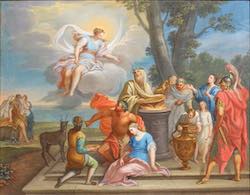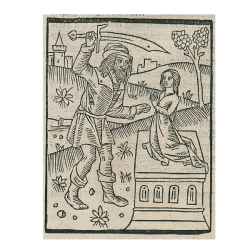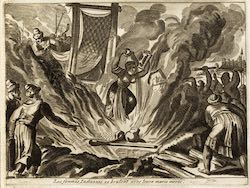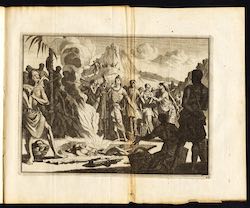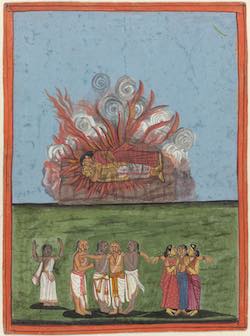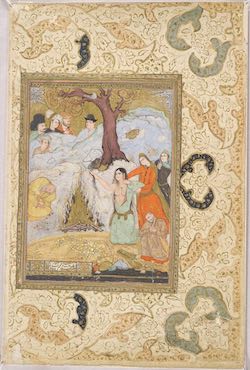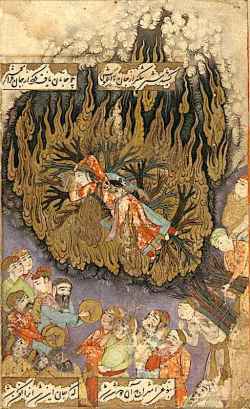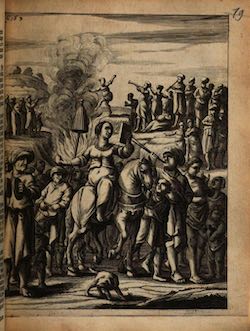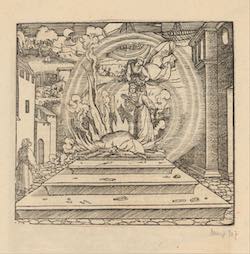Keyword: Women
Indian Woman Burning Alive (18th century)
http://www.columbia.edu/itc/mealac/pritchett/00routesdata/1800_1899/hinduism/sati/sati.html
Iphigenia Sacrifice (18th Century)
Private collection
Jephte sacrifices his daughter (1493)
from: Cest le mirouer de la redempcion humaine (GW M4304210), Fol, f4r [Paris]
Stabi, Berlin
Jephthah’s Daughter (16th Century)
Royal Collection Trust, London
Les femmes Indiennes se brulent (1725)
from: van der Aa, P. La galerie agreable du monde. Tome premier des Indes Orientales, Leiden, c. 1725
http://www.columbia.edu/itc/mealac/pritchett/00routesdata/1800_1899/hinduism/sati/sati.html
Les veuves du Cormandel (1725)
from: van der Aa, P. La galerie agreable du monde. Tome premier des Indes Orientales, Leiden, c. 1725
http://www.columbia.edu/itc/mealac/pritchett/00routesdata/1800_1899/hinduism/sati/sati.html
Naauw-keurige aanteekeningen van William Methold (1707)
from: van der Aa, P. Naauw-keurige aanteekeningen van William Methold, Presiden van de Engelsse Maatschappy, gehouden op sijn Voyagie, in het jaar 1619, Leiden, 1619
http://www.columbia.edu/itc/mealac/pritchett/00routesdata/1800_1899/hinduism/sati/sati.html
Queen Nzinga sacrifices a man [illustration of Dapper Naukeurige beschrijvinge der Afrikaensche gewesten] (1676)
from: Olfert Dapper, Naukeurige beschrijvinge der Afrikaensche gewesten, Amsterdam, Meurs,1668, p. 238
Satī (17th)
from: Manuscript, Iran
Harvard Art Museums/Arthur M. Sackler Museum, The Norma Jean Calderwood Collection of Islamic Art
Sati Funeral Practice (1611)
from: Johannes Isacius Pontanus, "Rerum et urbis Amstelodamensium historia", Amsterdam, 1611, p. 189
Satī. Gentile women of the caste of the cattle drivers, who is buried alive with her husband after he had died [1540]
Codice Casanatense, Biblioteca Casanatense, ms. 1889, fol. 64r, Rome
Satī. The bride immolates herself on the funeral pyre (1657)
from: Isfahan, Iran
The Israel Museum, Jerusalem
Scene of a Sati, with a woman throwing herself into the flames amid a crowd playing trumpets. Above, a winged devil holds the banner with the book's title and the torch with which he lights the ritual fire. (1670)
from: Abraham Rogerius, Le Théâtre de l’idolatrie ou la porte ouverte, Amsterdam, Jean Schipper, 1670, title page
Scene of a sati. In the foreground, a widowed woman (encountered by Della Valle on November 12, 1623) on horseback holds a mirror and a lemon amidst a crowd. In the background, a woman throws herself into the flames of a funeral pyre (1665)
from: Della Valle, Pietro, De volkome beschryving der voortreffelijke reizen van de deurluchtige reisiger Pietro della Valle, edelman van Romen, in veel voorname gewesten des werrelts, sedert het jaer 1615, tot in 't jaar 1626 gedaan. Amsterdam, Abraham Wolfgang, 1666, vol. 5, pag. 163
Suicide of a Woman on an Altar (1532)
from: Francesco Petrarca, Von der Artzney bayder Glück, des guten vnd widerwertigen: unnd weß sich ain yeder inn Gelück und Unglück halten sol; auß dem Lateinischen in das Teutsch gezogen, Augspurg, Steyner, 1532, p. clviii
Rijksmuseum Amsterdam
Suttee (1878)
from: Murray Smith, D. Round the World: A Story of Travel Compiled from the Narrative of Ida Pfeiffer, London, 1878
http://www.columbia.edu/itc/mealac/pritchett/00routesdata/1800_1899/hinduism/sati/sati.html


